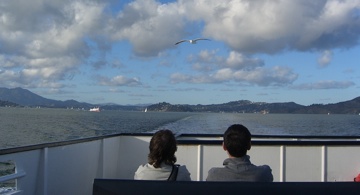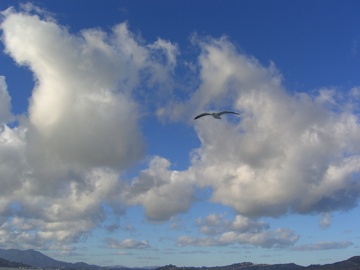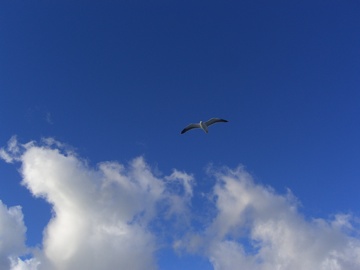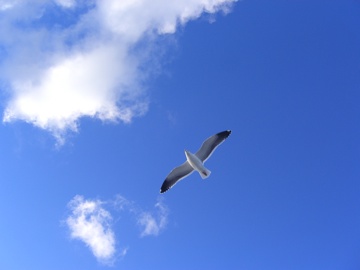The way things shook out last night, we would have had to rush to the Oakland ferry slip for our usual Friday night round-trip. So we decided to take it easy and do something else. “Something else” turned out to be going down to Cesar Chavez Park, the former Berkeley garbage dump, down on the bay. The Dog was so excited when he realized where we were going that he climbed into Kate’s lap in the front seat of the car when we got close to our destination. We parked right before the sun set, and took a long walk that looped down to the edge of the park, where the landfill ends and the bay sweeps out toward the Golden Gate, Angel Island and Marin County. A single sailboat was tacking along the waterfront, zigzagging its way back toward a berth in the Berkeley Marina.
Yellow Bay, Blue Bay
Bay, Before the Storm
Unhand Me, Grey-Beard Loon
“At length did cross an Albatross,
Thorough the fog it came ;
As if it had been a Christian soul,
We hailed it in God’s name.“It ate the food it ne’er had eat,
And round and round it flew.
The ice did split with a thunder-fit;
The helmsman steer’d us through!“And a good south wind sprung up behind ;
The Albatross did follow,
And every day, for food or play,
Came to the mariner’s hollo!”
However: ‘Twas not an albatross that glided into sight when we were on the ferry from Tiburon back to the city on Saturday, but a California gull. The gulls: They’re more familiar for their late-game invasions of local ballparks, swooping on peanuts, Cracker Jack, stub ends of hot dogs and stale buns. They appear in the hundreds and often put on a more interesting show than the paid performers on the field. Another habit they have, with which you’re familiar if you spend time on the water hereabouts: They trail boats, looking for any sign of free calories. This guy followed the ferry for five minutes or more. (Click for larger images.)
Technorati Tags: san francisco
Dump
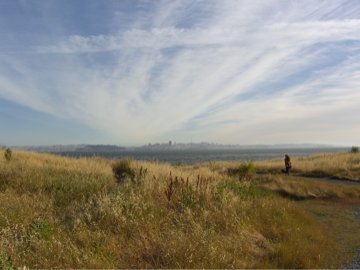
I don’t have the exact statistics at the ready, but something like 35 or 40 percent of San Francisco Bay has been filled since the region was settled in the 19th century. About 95 percent of the wetlands surrounding the bay have been diked, drained and developed. Berkeley’s most visible modern contribution to the great, undeclared bay transformation project is its old garbage dump, part of a complex of old fill projects that stretch more than a mile along the waterfront and extend more than three-quarters of a mile into the water from the old shoreline (which itself is at least one-third of a mile west of where the European interlopers found the water’s edge).
The dump was a great place. Noisy, smelly, full of garbage and construction debris, seagulls and big graders. I worked as a construction laborer for a while after I moved out here, and every once in a while was sent on a dump run to unload a pile of old shingles or lumber or fractured plaster and splintered lath. A cashier took your fee, then sent you on your way, out the potholed road to the mountain of discards. A worker out there directed you to the edge of a live pit, and you added your stuff to all the household garbage, old tires, unwanted furniture, lawn clippings and miscellaneous unidentifiable sweepings from all over the city. I would always feel a little exhilarated to see it all and to throw mine, whatever it was, in on top. The graders and other heavy equipment were constantly at work crushing the trash, packing it down, making room for more; once a pit was full, it would be covered with dirt and the garbage would go to a new one. The old pits would settle over time and be reopened to take on more refuse. This went on for years.
About two decades ago, the dump reached capacity. So much garbage had been packed in that at one point it had been squeezed out in the Bay under the dikes built to contain the fill. The city built a “transfer station,” a big open warehouse-like structure where all the trash would go to be sorted and re-transported, if it wasn’t recyclable or compostable. The old dump was covered with dirt, lots of dirt. Part of it was landscaped and turned into a manicured city park and named after Cesar Chavez, the late farmworkers’ labor leader. Most of the fill was planted with native flora and studded with pipes to vent the methane and other gases from the old buried trash. Roads and trails were built. Part of the semi-wild-looking area at the center of the old dump has been opened up as a park for off-leash canines.
So, at the end of this environmentally unfriendly epic (a story line shared with many great city parks, like Grant Park in Chicago), we’ve got a beautiful piece of waterfront property with staggering views across the bay and back toward the hills, filled with bike riders, hikers, dog-walkers, picnickers and kite-flyers. Our garbage? It’s headed someplace else, where it’s unlikely to grow into something similar.
Technorati Tags: berkeley, california

